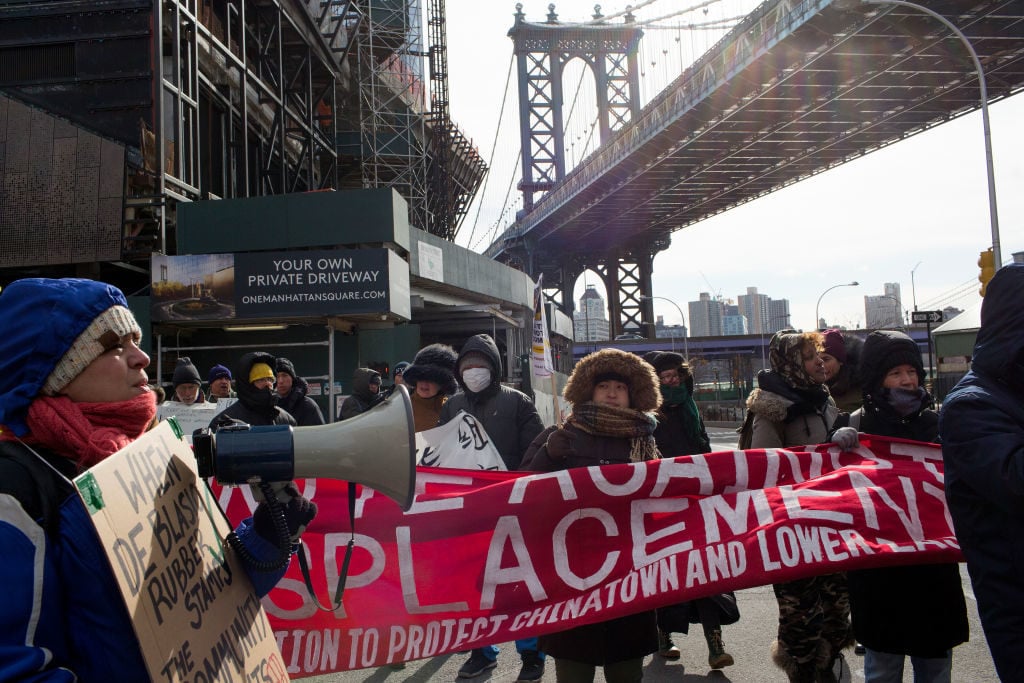Politics
An Artist-Led Coalition in New York City Has Won a Big Legal Victory Against a Real Estate Developer’s Planned Skyscrapers
A New York state judge has nullified the city’s approval for the project.

A New York state judge has nullified the city’s approval for the project.

Zachary Small

Residents of the Two Bridges neighborhood in New York, bolstered by artists in their ranks, have won a lawsuit against a group of real estate developers who proposed a luxury skyscraper complex in the area. The local victory is the fourth recent court decision to negate the city’s approval of such projects.
“This is very emotional for me,” said Jamie Chan, an artist who spent the past year organizing against the development as a member of the activist group Art Against Displacement (AAD), a member of the Coalition to Protect Chinatown and the Lower East Side.
“It felt like we were constantly having to fight politicians who were never on our side because they were in cahoots with the developers.”
In his decision, a state judge barred developers from building four high-rise towers that would have included thousands of pricey apartments. The administration of New York mayor Bill de Blasio had sided with the developers, arguing that because the towers did not require special permits, certain environmental reviews were not necessary.
Developers had previously used the same argument to fast track the development past the city’s exhaustive land-use review process, which would have required input from neighborhood residents, many of whom worried that the plan violated local zoning rules meant to safeguard the area’s air quality and sunlight.
Filing his decision on Monday, Judge Arthur Engoron agreed with activists and nullified the city’s approval for the project.
Before the recent court ruling, members of AAD collected 5,000 signatures from local residents who opposed the Two Bridges development.
“Beyond stopping these towers, the primary point is that we are advocating for the Chinatown Working Group,” explained the artist Vanessa Thill, referring to a community-led rezoning plan for the neighborhood that seeks to prevent over-development and displacement.
The city’s law department says it is evaluating its next steps, including the possibility of an appeal. In a statement, the developers—JDS Development, L+M Development, CIM Group, and Starrett Corporation—signaled that they would appeal the decision.
Chinatown and the Lower East Side are home to dozens of galleries, and many dealers have openly worried that upscale development and the tides of gentrification would force them to relocate or go out of business.
AAD was cofounded in 2017 by the artist Margaret Lee, who ran the 47 Canal gallery, as a response to the neighborhood’s rapid development. Among the group’s roughly 40 members is Heather Hubbs, the executive director of NADA.
Many members say they joined the cause after being outraged by German artist Kai Althoff’s 2018 exhibition staged inside a Chinatown mall. Critics, including Chan, described the show as cruelly exoticizing and complicit with the displacement of Chinese immigrants.
“The relationship between art and urban centers is complicated,” Andrew Fairweather, another artist involved with AAD, told Artnet News. “Artists are often thought of as precursors to things like gentrification, but we can redeem whatever role artists have played in gentrification by building a better future.”
The artist Francisca Benitez has lived on the Lower East Side for more than a decade, joining the Coalition in 2015 when she saw the group marching down her street. Later, she joined AAD.
“We stand in solidarity against gentrification,” she said. “This court decision invigorates our struggle. But this is more than a struggle for one plot of land; we have plans for the whole neighborhood.”
The affordable housing crisis has hit cities across the United States, widening the economic gap between renters and homeowners. In San Francisco, some experts have advocated for a rapid building program that would add housing units without regard to affordability, looking to increase space in a city where jobs outnumber apartments by a ratio of eight to one.
In New York, activists say that such a plan would fail to help those in immediate danger of displacement. In a city where more than a quarter of luxury high-rises are vacant and the homeless population steadily climbs, activists are looking for different solutions.
“It’s important to emphasize that we are not anti-development,” Thill said. “We aren’t saying there shouldn’t be change. We just want affordability. It’s life or death for the neighborhood.”